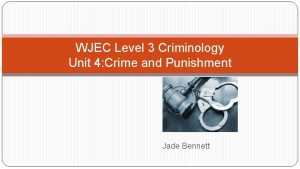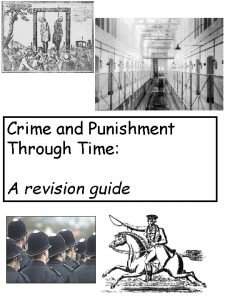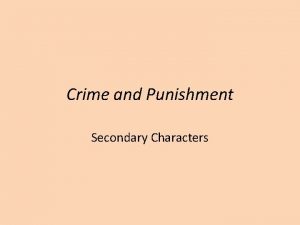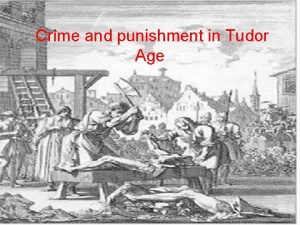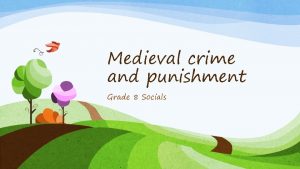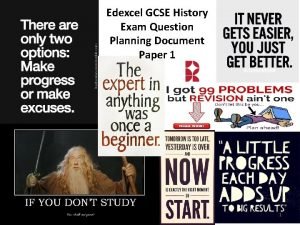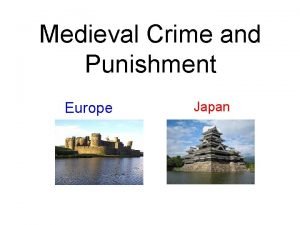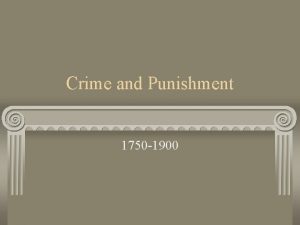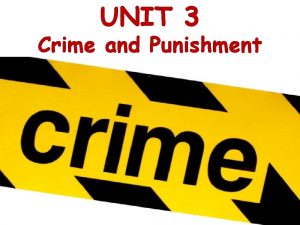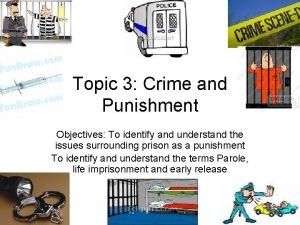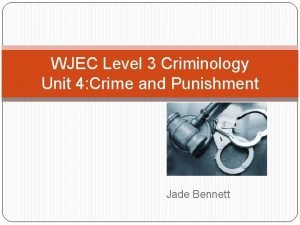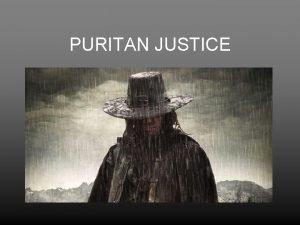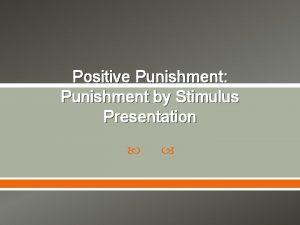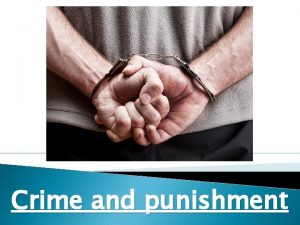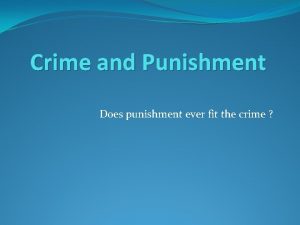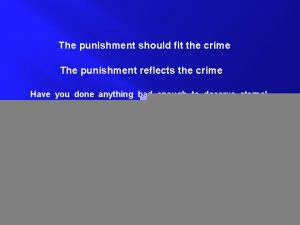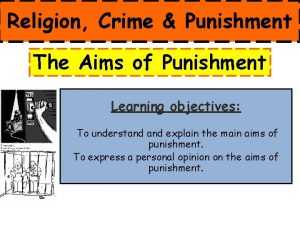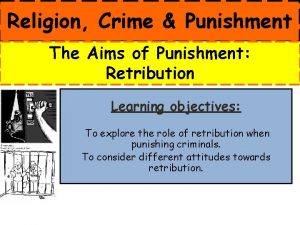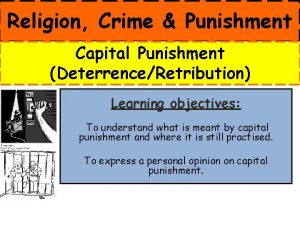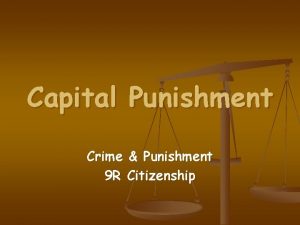An introduction to Crime and Punishment through time















- Slides: 15

An introduction to Crime and Punishment through time, c. 1000 -present day Getting ready for GCSE History In September, you will be starting your History GCSE with Paper 1: Crime and Punishment through time, c. 1000 -present day. Over the Summer, we would like you to begin to prepare for this. In this booklet you will cover • What you think you already know about Crime and Punishment • Develop chronological skills which are necessary for this paper • Gain an understanding of the ‘big picture’ of Crime and Punishment through time and identify how it changed over time • Identify the factors which contributed to why Crime and Punishment changed. Please complete this booklet over the Summer Holidays and either email to your teacher or hand it in at school in September. Make sure you are also checking Google Classroom as we will be posting updates to get you ready for this paper. If you have any questions in the meantime please email your teacher. Have a lovely Summer and we look forward to seeing you again in September! 1

What are your attitudes to crime and punishment? Task 1: Read through the questions and circle which statement you agree with for each question. Think about the reasons why you believe this as we will discuss this in our first class back. 1. What should be the main reason behind punishing criminals? a) Retribution – revenge to satisfy the victim or their families b) Deterrence – to warn others not to commit the same crime c) Reform – to help the criminal improve their behaviour d) Removal – to keep the criminals of the streets 2. Should capital punishment (the death penalty) be brought back? a) Yes, for all murders b) Yes, for some murders c) Yes, for certain types of serious crime d) No 3. Should physical punishments, such as whipping, be used against criminals? a) Yes b) No 4. Should be police carry guns? a) Yes, all the time b) No, unless there is a dangerous situation to deal with c) Only in some areas d) Never Key Words Write down your own definition of each key word Retribution Deterrence Reform Removal Capital Punishment 2

What do you already know about crime and punishment? Task 2: Read through the questions and circle which statement you think is correct. 1. In the last ten years crime has: a) Risen dramatically b) Stayed roughly the same c) Fallen 2. Who is more likely to be the victim of a mugging? a) A female pensioner b) A male pensioner c) A female under 29 d) A male under 29 3. Yearly numbers of murders and killings are: a) Slightly higher than they were ten years ago b) Considerably higher than they were ten years ago c) Slightly lower than they were ten years ago d) Considerably lower than they were ten years ago 4. In the last ten years, car crime (theft of cars and possessions from cars) has: a) Increased dramatically b) Increased a little c) Decreased dramatically 5. Women are more likely than men to be attacked by a stranger? a) True b) False 3

6. Burglary is: a) Increasingly dramatically b) Increasingly a little c) Decreasing dramatically 7. What percentage of rimes are violent? a) 50 percent b) 35 percent c) 10 percent d) 3 percent Answers to Crime Quiz 1 c; 2 d; 3 d; 4 c; 5 b; 6 c; 7 d 4

Understanding Chronology In this topic, you are going to cover 1000 years of History. Therefore it is important that your knowledge of chronology (the names and sequences of different historical periods) is strong and you can confidently write about these different historical periods. 1. Place these four historical periods in chronological order. The first one has been done for you. • The twentieth century • The Middle Ages • The Early Modern Period • The Eighteenth and Nineteenth Centuries Earliest Period The Twentieth Century Most Recent Period 2. Roughly, what dates does each period cover. The first one has been done for you. The Twentieth Century 1900 -1999 The Middle Ages The Early Modern Period The Eighteenth and Nineteenth Century 3. Place these events in the correct chronological order. The Black Death The Renaissance The Industrial Revolution The Norman Conquest The First World War The English Civil War 4. You are going to study four pictures (picture A-D. ) With each picture, you need to identify • Which chronological period you think the picture is from • What do you think is happening in each picture • What can you work out from each picture about Crime and Punishment at that time? Does it reveal a type of crime, a method used to enforce the law or a method used to punish criminals? 5

Which chorological period? What do you think is happening in this picture? What does this reveal about Crime and Punishment at that time period? 6

Which chorological period? What do you think is happening in this picture? What does this reveal about Crime and Punishment at that time period? 7

The Big Story of Crime and Throughout this topic, you. Punishment will study the crime and punishment over 1000 years. We will focus on four periods: • • 1000 -1500 -1700 -1900 -present day For each period in time we look at, you will learn about 1. Criminal Activity – what people thought was a crime 2. How the law was enforced 3. How criminals were punished On the next page, there is an overview of Crime and Punishment 1000 -1500. (Please be mindful this is an overview and not the complete story of Crime and Punishment. ) Task: Using the pages provided, create your version of a mind map for each of the four time periods. You must include these three headings • Criminal Activity – What was the nature of crime in each period • Methods used to enforce law – What was the role of authority and communities in law enforcement • Methods used to punish criminals – What was the main purpose of punishment? 8

9

Crime and Punishment 1000 -1500 10

Crime and Punishment 1500 -1700 11

Crime and Punishment 1700 -1900 12

Crime and Punishment 1900 present 13

Why changes happened – and didn’t The focus of this topic is both how crime changed over time (which you will have seen in the previous task) and then importantly why crime and punishment changed. Here you will learn about the factors (the reasons) for changes in crime and punishment or the reasons for staying the same. Read the diagram above a) The factors above the triangles have had the most important impact on Crime and Punishment throughout History. b) The factors below the triangle have been important in certain periods of history but not as consistently throughout time. Task: Choose two of the factors above and decide which period of time you think it would have had the most impact on and why. Factor Which time period do you think this Explain why you think factor impacted the most? this. 14

Task: Below are three important moments in the History of Crime and Punishment. Read through each moment and identify which factors are influencing the people and events described in each one. Event Which factors? The Gunpowder Plot The First Police Force in London Capital Punishment is abolished 15
 Wjec criminology unit 3 notes
Wjec criminology unit 3 notes Crime and punishment revision guide
Crime and punishment revision guide Porforios
Porforios Tudor crime and punishment
Tudor crime and punishment Wjec criminology unit 4 revision
Wjec criminology unit 4 revision Medieval crime and punishment facts
Medieval crime and punishment facts Gcse history past papers edexcel
Gcse history past papers edexcel Kahoot crime and punishment
Kahoot crime and punishment Crime and punishment in medieval japan
Crime and punishment in medieval japan Crime and punishment 1750 to 1900
Crime and punishment 1750 to 1900 Examples of internal forms of social control
Examples of internal forms of social control Crime and punishment key words
Crime and punishment key words Crime and punishment topic
Crime and punishment topic Criminology unit 4 revision
Criminology unit 4 revision Tsw crime and punishment
Tsw crime and punishment Puritanical methods of punishment
Puritanical methods of punishment
